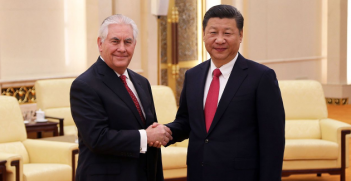Inspiring Infrastructure as an Ideal Way Forward

In order to attract private sector investment, Dr Stephen Grenville proposes a progressive G20-led collaboration between multilateral development banks, credit rating agencies and government.
As chair of the G20 in 2014, Australia has identified infrastructure investment as a priority issue. The need is apparent, not just in emerging economies, but in economies such as Australia and the US. At the same time there seems to be the wherewithal to build it, with productive slack in many countries and low global interest rates, identifying a “savings glut” and ample finance. So, why doesn’t more happen and how can the G20 help?
Infrastructure embodies a number of intractable problems. Characteristically large scale, high-profile, long-lived and highly capital intensive mistakes can be costly – not just financially but politically. Projects tend to inevitably run into public disagreement and arguments about priorities, or frequently impinge on sensitive ownership rights: land resumption isoften an issue. And it is accepted that vested interests who will benefit from the construction, operation and funding will be lobbying hard.
Stuck in the “Too-Hard” Basket
Pricing presents key challenges. Consumers often expect to access the service (whether a road or water supply) for free or at a subsidised price. Such projects often provide large social benefits and externalities – a toll road not only benefits those whouse it, but also those who use other now less-crowded roads, while also raising adjacent land values. However, even where the project has a high social return, actualcash earnings are often insufficient to meet operating costs and debt servicing. So, should the project still go ahead, justifiable solely on the basis of its social value? And if so, who will meet the uncovered costs?
To complicate things further, this pricing can’t routinely be left to the free market to sort out. By their very nature, many infrastructure projects create natural monopolies, where one supplier servesa market without close competition. An airport, electricity or water supply, a vital bridge link – all of these are natural monopolies, where price regulation will be necessary (and probably regulation of quality-of-service and reliability as well). This regulation will inevitably be imperfect and controversial. Thus, regulatory risks (the possibility of unfavourable decisions) are among investors’ greatest concerns.
All these complexities impinge on the core problem: before investment, it is often hard to separate good projects from white elephants. So questions have to be asked, and they can include the following: What traffic will a toll road attract? What will it cost to build this once-off, unique project? What are the appropriate technical specifications? Should the project cater for today’s demand, or have a far-sighted view of the future, even if this extra capacity won’t earn immediate revenue? Above all, how much risk are those who are responsible for the project prepared to take? Once a project gets underway, it is almost always sensible to see it through to conclusion, even if the implementing body is unable to do so. The ultimate risk then reverts to the government.
Calling in Some Expert Advice
After setting out the spectrum of challenges in this way, it is clear that the most difficult issues lie in the domestic sphere. Some issues are technical, but many lie squarely in the domain of domestic politics. Inthis context, what role does international cooperation in general, and the G20 in particular, have to offer?
Effective project appraisal is the key issue straddling both domestic and international domains. Not only should it address any political issues with particular clarity, when it comes to specifying risk-sharing, thorough appraisal is needed for the largely domestic task of identifying viable projects and avoiding white elephants. However, there is also an important global dimension: infrastructure projects have to be linked with the investors, some of whom are likely to be foreigners.
Worldwide, there is a deep body of infrastructure experience, which might be effectively harnessed on the specific issue of project appraisal – not to displace the domestic decision-making processes but to give them the benefit of prior experience. One obvious source is multilateral development banks (MDBs) – like the World Bank – and regional development banks, such as the Asian Development Bank. Some decades ago, infrastructure was their “bread ’n’ butter”. More recently, these banks havestepped back from this degree of direct involvement, constrained by the pressures to spread their modest balance portfolios widely – but their main contribution may be to reassemble their prior levels of technical expertise in project appraisal. For example, the International Finance Corporation has funding experience that could be brought to bear.
Unlocking Lessons from MDBs
G20 already has a Study Group on Financing for Investment. Each of the MDBs have begun to address the challenge, but these efforts remain conceptual and have yet to become relevant at the operational level.
Drawing on the expertise of the MDBs is not enough, in itself, to link investors with infrastructure projects. One of the missing links in the infrastructure funding chain is between the physical project and the large pools of savings residing in pension funds and sovereign wealth funds. To tap into these would require the active participation of the gatekeepers of these large funds – the credit rating agencies (CRAs).
At present, the expertise of the CRAs is at too high a level, too broad-brush to be relevant for detailed project appraisal. If, however, the CRAs worked together with the MDBs’ technical experts, the necessary synthesis of engineering, administration and finance might be developed over time.
The Role of Government
The complex characteristics of infrastructure give governments a leading role to play, especially in the initial stages of financing projects. Conventionally, government infrastructure funding fares badly in financial analysis, because debt is widely assessed by crude measures such as the ratio of debt-to-GDP. But this takes no accountof whether the debt was incurred to fund routine current expenditure or, in the case of infrastructure, to fund an income-earning asset. Well-structured infrastructure strengthens rather than weakens any government’s balance sheet, so debt assessment ought to reflect this. Budget accounting needs to reflect the distinction between current and capital expenditure,and the CRAs need to carry this distinction into their global assessments.
The G20 provides countries with peer-pressure and motivation to improve their investment environment, tackling the challenges outlined here within their own domestic sphere. It can also encourage MDBs to focus more sharply on infrastructure. The real question is: can the G20 go beyond this focus and bring together a wider range of global skills, which could raise the standard of infrastructure project appraisals? This is a challenge worthy of the lofty ideals of G20.
Dr Stephen Grenville AO is a Visiting Fellow at the Lowy Institute for International Policy and works as a consultant on financial sector issues in East Asia.
This is an extract from G20: Words into Action Brisbane 2014, to be published by Faircount Media in association with the Australian Institute of International Affairs in October 2014.





